Table of Contents
- Introduction
- Editor’s Choice
- Global Vending Machine Market Statistics
- Types of Vending Machine Statistics
- Vending Machine in Operation – By Location Statistics
- Vending Machine Operators – By Company Size Statistics
- Type of Goods Sold Through Vending Machine Statistics
- Price Range of Various Goods Sold Through Vending Machine Statistics
- Number of Vending Machine Operators – By Employment Size Statistics
- Vending Machines Sales Statistics
- Unit Economics of Vending Machine Items
- Consumer Preferences for Vending Machines
- The Role of Healthy Snack Vending Machines in Employee Wellness Programmes
- Cost and Investments in Vending Machines
- Recent Developments
- Conclusion
- FAQs
Introduction
Vending Machine Statistics: Vending machines, ubiquitous in modern retail, come in various types, from food and beverage dispensers to ticket and service providers.
Users select items via buttons or touchscreens and pay with coins, bills, cards, or mobile options. The machines then dispense the chosen product, aided by inventory management systems that track stock levels for timely restocking.
Offering convenience, cost-efficiency, and accessibility, vending machines represent a passive revenue stream for businesses, with data insights informing consumer preferences.
Trends include healthier options, cashless transactions, smart technology integration, customization features, and a focus on sustainability.
As they continue to evolve, vending machines remain vital in meeting consumer needs while adapting to technological advancements and sustainability initiatives.
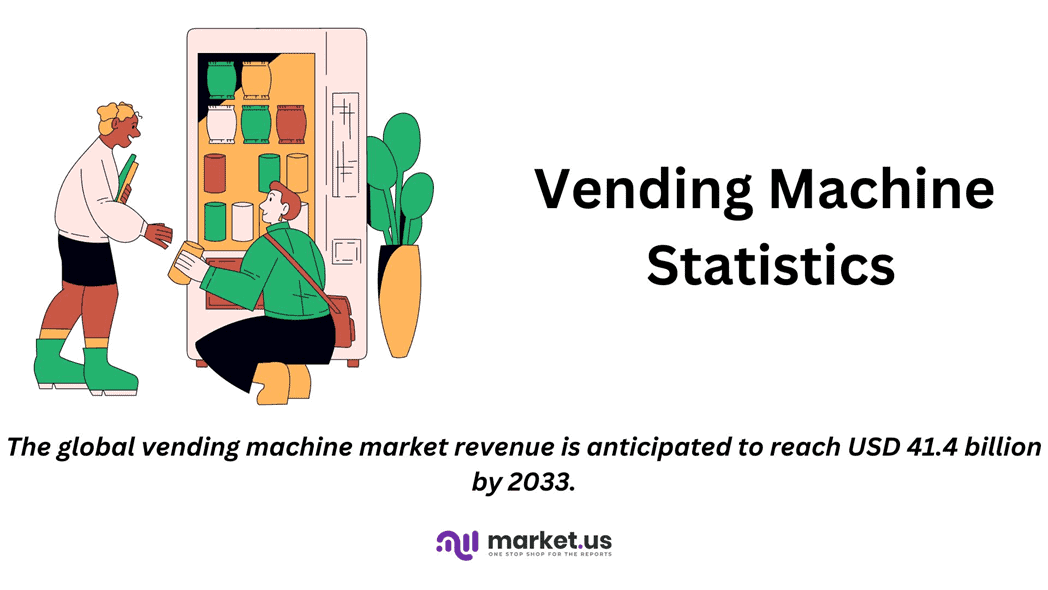
Editor’s Choice
- The global vending machine market revenue is anticipated to reach USD 41.4 billion by 2033.
- Westomatic Vending Services Ltd. leads the market with a 15% share.
- The global vending machine market is segmented by region, with North America holding the largest market share at 33.0%.
- In 2019, the distribution of vending machines across various locations within the industry showed a diverse allocation. Manufacturing sites had the highest concentration of vending machines, accounting for 30.20% of the total.
- In 2019, the vending machine industry was predominantly composed of small operators. With 67.10% of all operators generating annual revenues of less than USD 1 million.
- In 2019, the distribution of vending machines across various locations within the industry showed a diverse allocation. Manufacturing sites had the highest concentration of vending machines, accounting for 30.20% of the total.
- The retail sales revenue of vending machines in China is expected to reach 73.93 billion yuan by 2027.
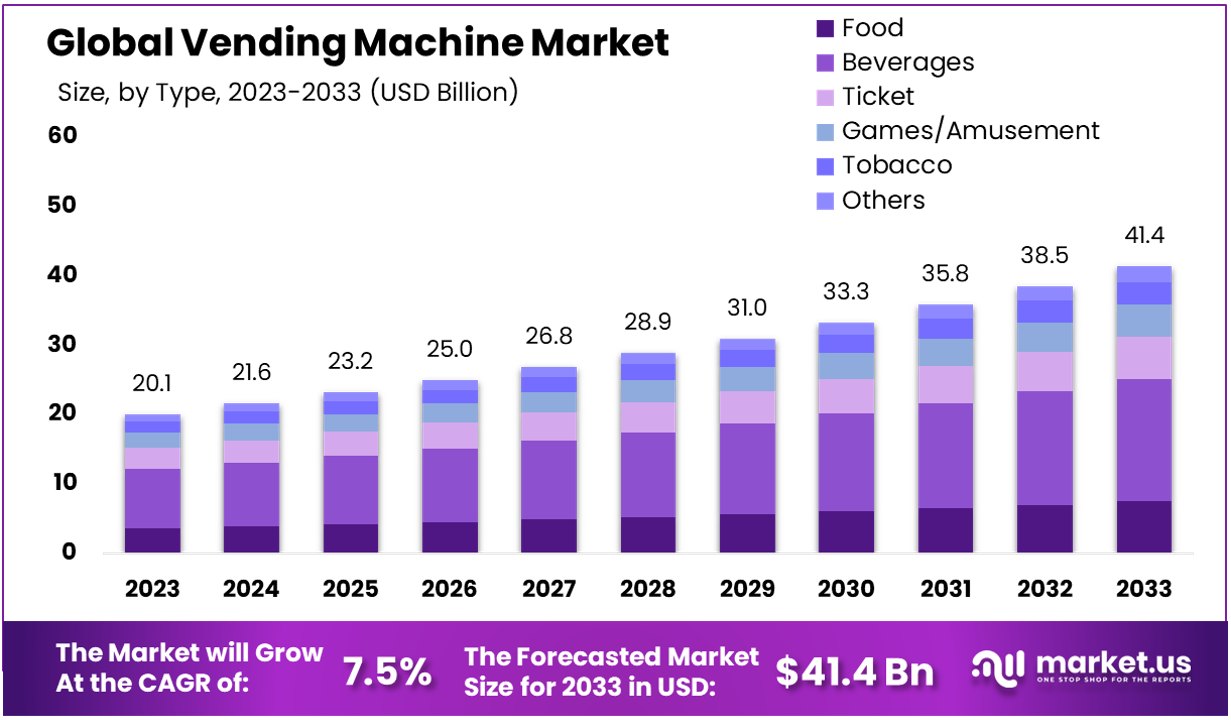
Global Vending Machine Market Statistics
Global Vending Machine Market Size Statistics
- The global vending machine market has demonstrated consistent growth over the past decade at a CAGR of 7.5%.
- In 2023, the market revenue was recorded at USD 20.1 billion.
- This upward trend is projected to continue, with revenues expected to reach USD 21.6 billion in 2024 and USD 23.2 billion in 2025.
- By 2026, the market is anticipated to grow to USD 25.0 billion. Further increasing to USD 26.8 billion in 2027 and USD 28.9 billion in 2028.
- The momentum is forecasted to sustain, with revenues climbing to USD 31.0 billion in 2029 and USD 33.3 billion in 2030.
- The market is expected to reach USD 35.8 billion in 2031 and USD 38.5 billion in 2032, culminating in an estimated revenue of USD 41.4 billion by 2033.
- This growth trajectory reflects the increasing demand for vending machines globally, driven by technological advancements and consumer preferences for convenience.
(Source: market.us)
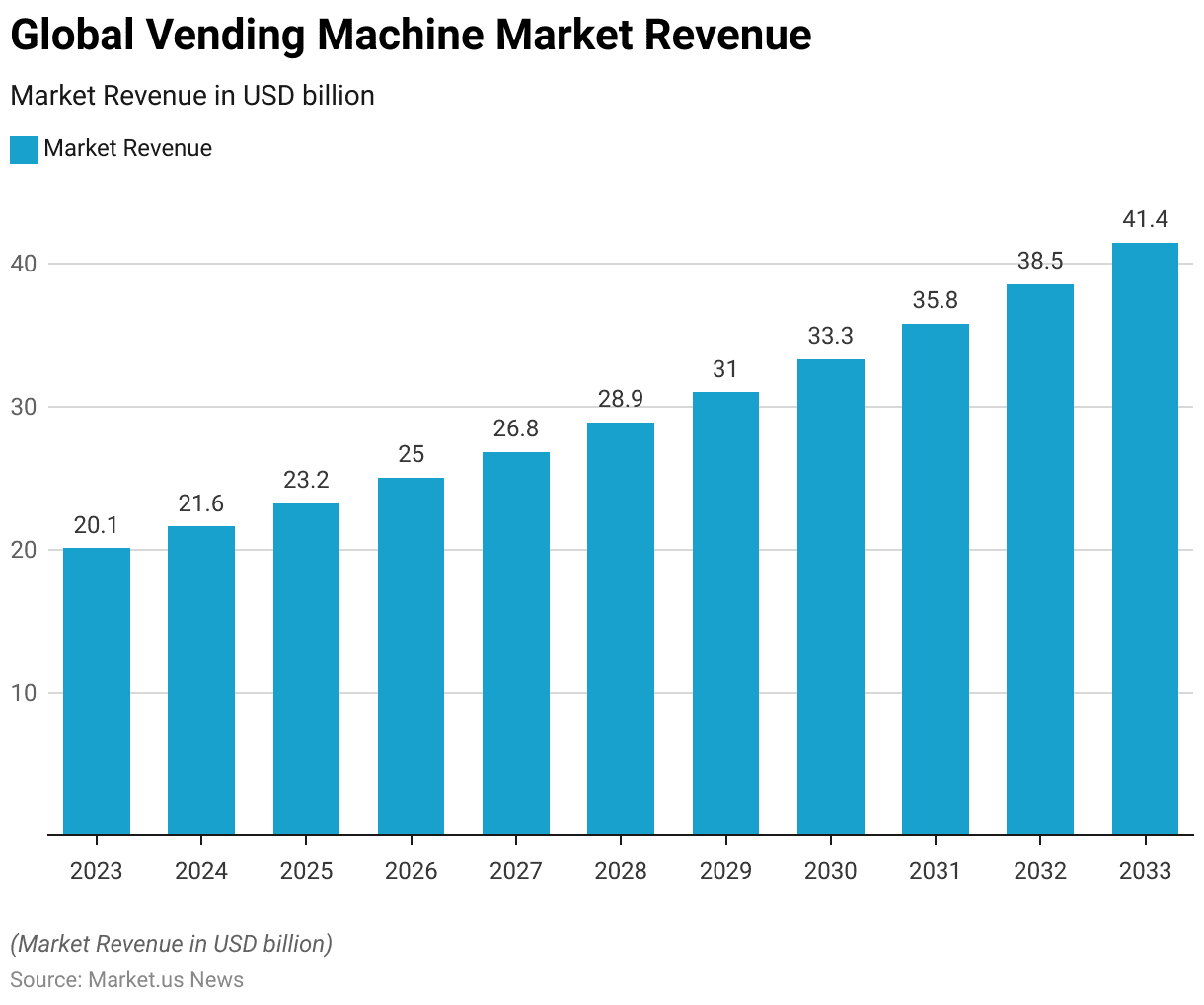
Competitive Landscape of the Global Vending Machine Market Statistics
- The global vending machine market is dominated by several key players, each holding a significant market share.
- Westomatic Vending Services Ltd. leads the market with a 15% share. Followed closely by The Azkoyen Group and Royal Vendors, Inc., each capturing 14% of the market.
- Glory Ltd. holds a 13% share, while Sanden Corporation accounts for 11%.
- Seaga Manufacturing Inc. and Orasesta S.p.A. both hold 9% of the market.
- Fuji Electric Co., Ltd. commands an 8% share, and Cantaloupe, Inc. holds a 7% share.
- These companies collectively represent a substantial portion of the global vending machine market, driving innovation and growth in the industry.
(Source: market.us)
Take advantage of our unbeatable offer - buy now!

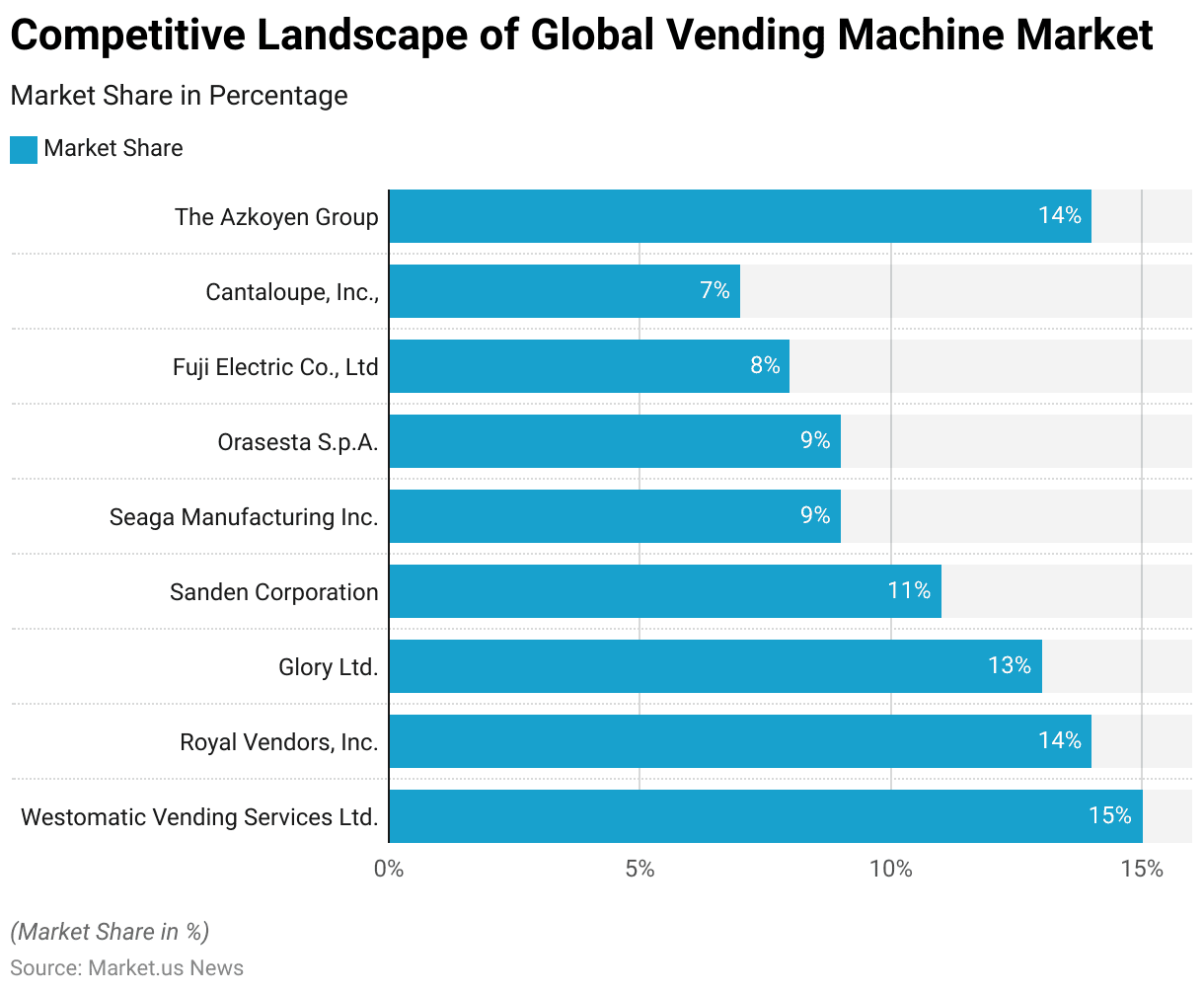
Regional Analysis of the Global Vending Machine Market Statistics
- The global vending machine market is segmented by region, with North America holding the largest market share at 33.0%.
- The Asia-Pacific (APAC) region follows closely, accounting for 28.0% of the market.
- Europe also has a significant presence, with a 25.0% share.
- South America and the Middle East & Africa (MEA) regions represent smaller portions of the market. With shares of 7.1% and 6.9%, respectively.
- This regional distribution highlights the widespread adoption and growth potential of vending machines across different parts of the world.
(Source: market.us)
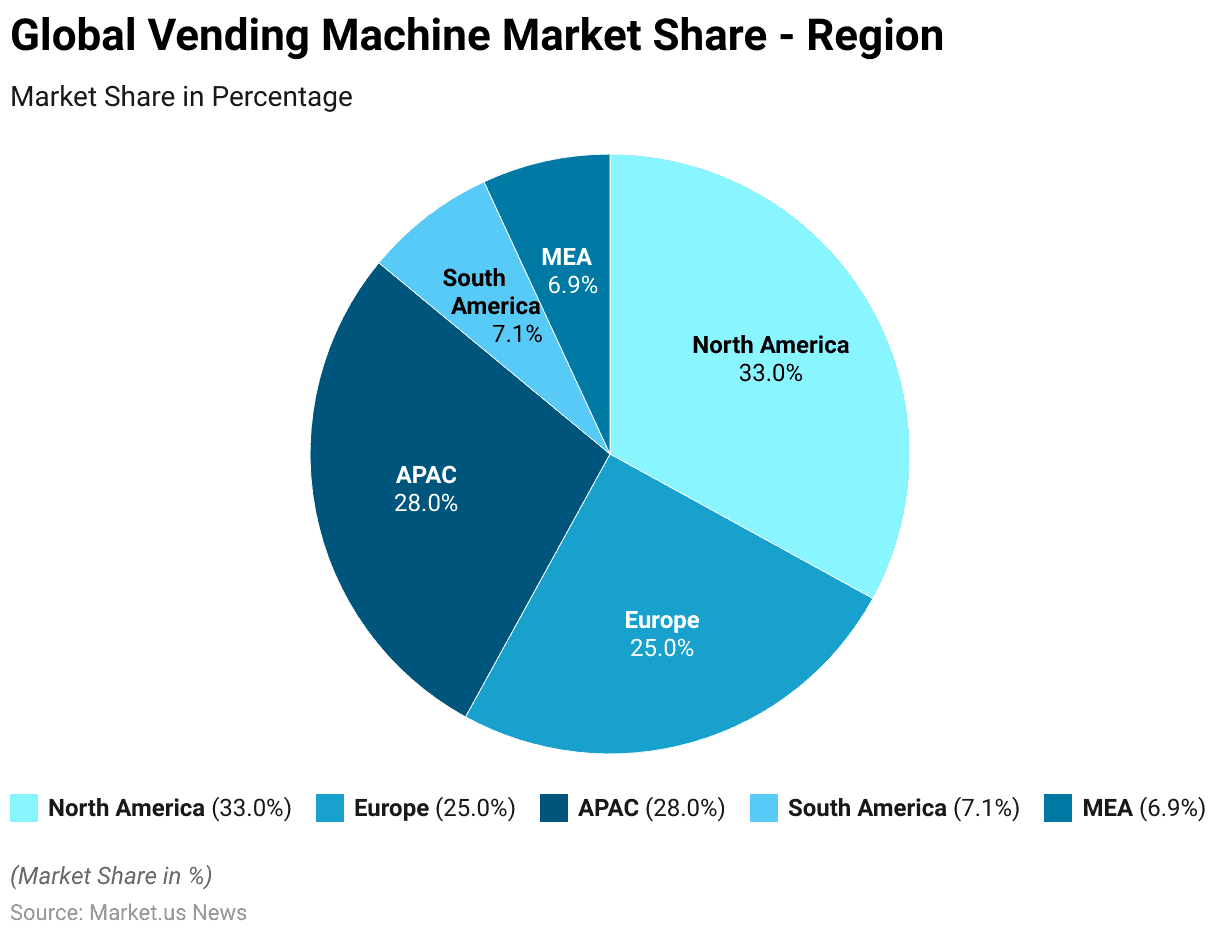
Types of Vending Machine Statistics
- Vending machines come in various types, each designed to cater to specific consumer needs and environments.
- Common types include snack vending machines, which offer items like chips, candy bars, and healthier snacks such as granola bars.
- Beverage vending machines dispense drinks, including soft drinks, water, and juices. Coffee vending machines provide a range of hot beverages, including espresso, cappuccino, and lattes.
- Combo vending machines combine snacks and beverages in one unit, optimizing space and offering variety.
- Advanced smart vending machines integrate features like touchscreens, digital payments, and mobile app connectivity, enhancing user convenience and operational efficiency.
- These machines typically measure between 68 to 72 inches in height, 29 to 41 inches in width, and 30 to 36 inches in depth.
- Additionally, specialized machines, such as hot food vending machines. Provide fresh meals like hot dogs and pizzas, with dimensions around 75 inches in height, 55 inches in width, and 38 inches in depth.
- These diverse vending solutions cater to various locations. Including offices, schools, airports, and public spaces, ensuring accessibility and convenience for users.
(Sources: Vending Pro Service, Betson, Convenience Services Group, Vending Locator)
Vending Machine in Operation – By Location Statistics
- In 2019, the distribution of vending machines across various locations within the industry showed a diverse allocation.
- Manufacturing sites had the highest concentration of vending machines, accounting for 30.20% of the total.
- Offices followed with 25.40%, reflecting a significant presence in workplace environments.
- Hotels accounted for 12.70% of vending machine placements, while schools held 9.90%.
- Retail locations had a 7.30% share, and hospitals accounted for 6.20%.
- Military bases, bars, and clubs had smaller shares, with 4.70% and 3.60%, respectively.
- This segmentation underscores the widespread utilization of vending machines across different sectors. Catering to a variety of consumer needs and preferences.
(Source: Zachary Crockett / The Hustle)
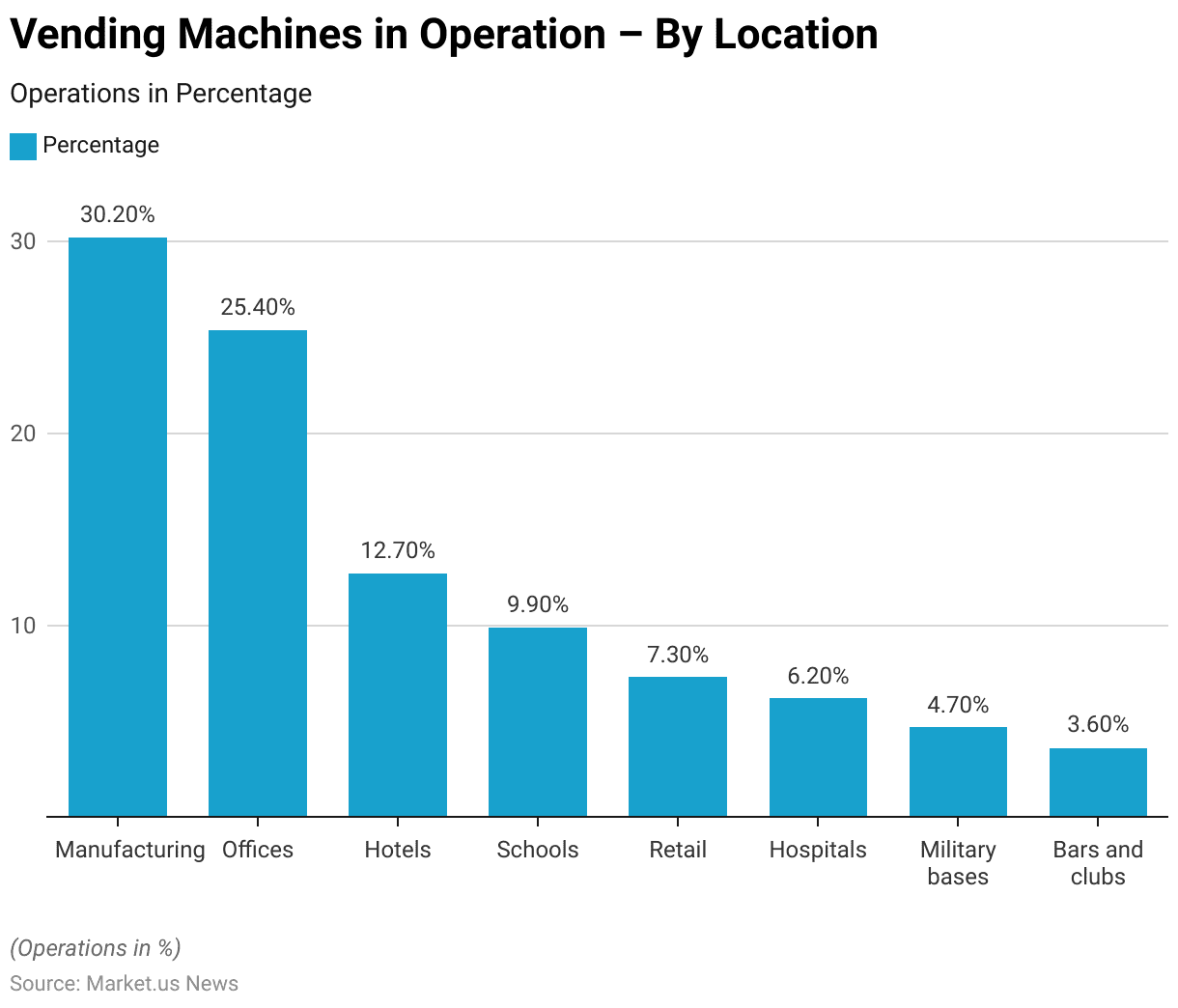
Vending Machine Operators – By Company Size Statistics
- In 2019, the vending machine industry was predominantly composed of small operators. With 67.10% of all operators generating annual revenues of less than USD 1 million.
- Medium-sized companies, with annual revenues ranging from USD 1 million to USD 4.9 million, accounted for 16.50% of the market.
- Large operators, earning between USD 5 million and USD 9.9 million annually, represented 7.10% of the industry.
- Extra-large companies, with annual revenues exceeding USD 10 million, made up 9.40% of all vending machine operators.
- This segmentation highlights the significant presence of smaller businesses within the vending machine industry. Alongside a notable contribution from medium to large-scale operators.
(Source: Zachary Crockett / The Hustle)
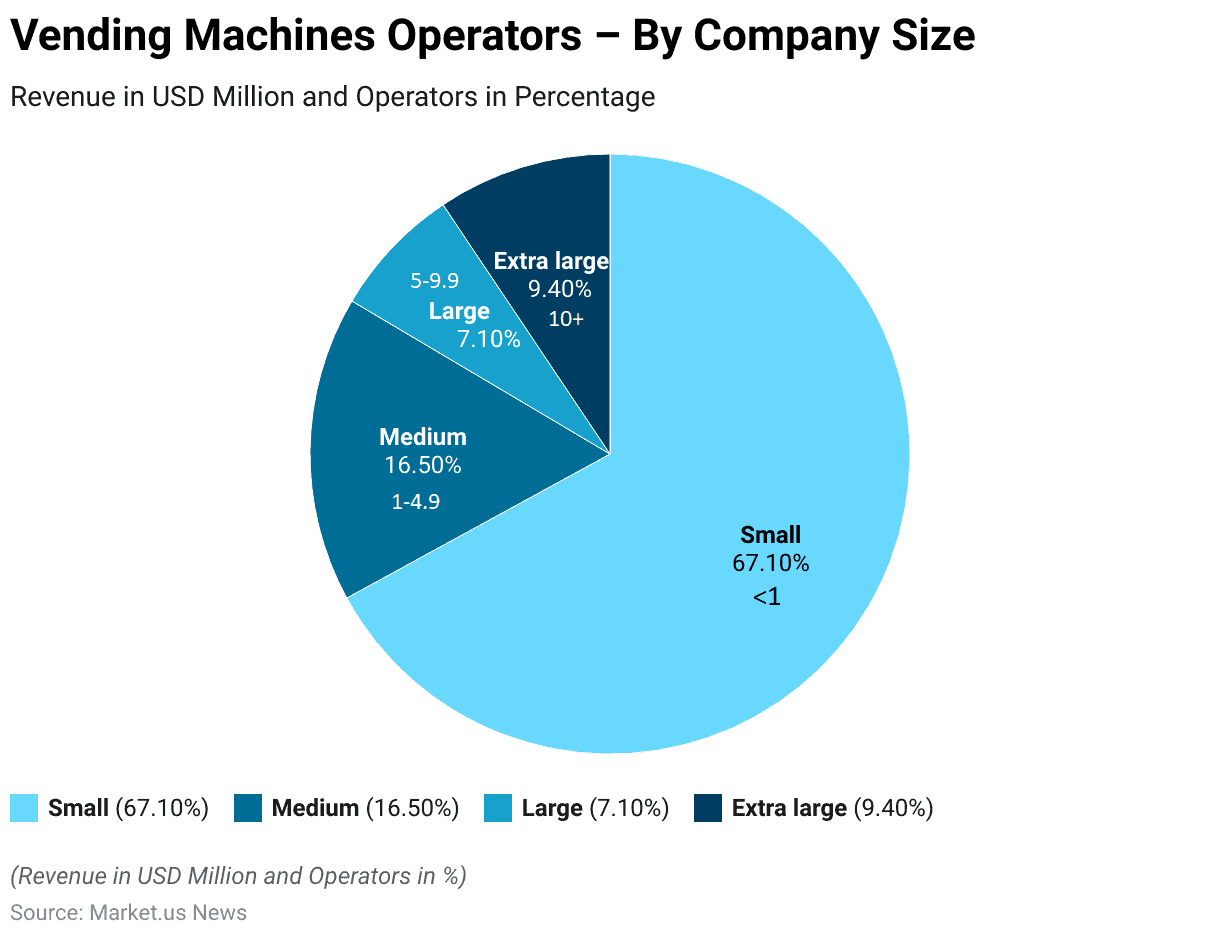
Type of Goods Sold Through Vending Machine Statistics
- In 2019, the vending machine industry showcased a diverse range of goods sold through these automated units.
- Snacks and food items dominated the market, accounting for 38.70% of the goods sold. Beverages followed closely, making up 33.70% of the market.
- Bulk candy represented 12.60%, catering to consumers seeking quick and sweet treats.
- Health-conscious products, such as nutritious snacks and beverages. Constituted 7.90% of the goods sold, reflecting a growing trend towards healthier eating habits.
- The remaining 7.10% included a variety of other items, encompassing miscellaneous products tailored to specific consumer needs and preferences.
- This segmentation highlights the broad appeal and versatility of vending machines in meeting diverse consumer demands.
(Source: Zachary Crockett / The Hustle)
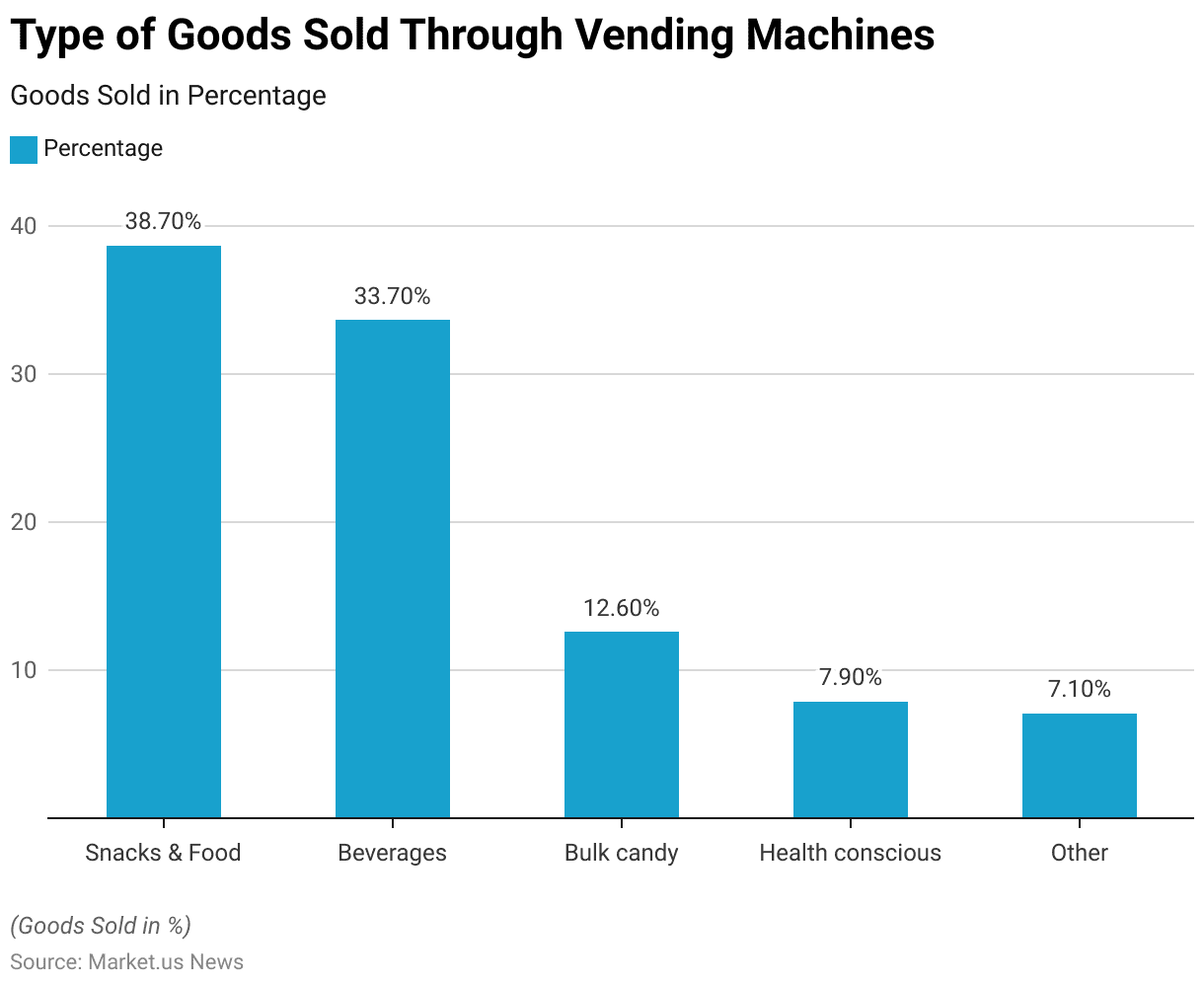
Market Share of Products Sold Through Vending Machine Statistics
- From 2009 to 2010, the market shares of products sold through vending machines in the U.S. experienced some shifts.
- Packaged cold beverages remained the dominant category. Although their share decreased from 56.12% in 2009 to 54.20% in 2010.
- Snacks, confections, and pastries also saw a slight decline, from 23% to 22.50% over the same period.
- Conversely, hot drinks increased their market share from 6.80% to 8.40%.
- Vended food saw a modest rise from 6.50% to 6.70%.
- The market shares of ice cream decreased marginally from 2.10% to 2%, while milk slightly increased from 1.80% to 1.90%.
- Bulk vending remained stable at 1% across both years. Cold drinks served in cups saw an increase from 0.60% to 1%, and the market share for cigarettes and cigars rose from 0.60% to 0.70%.
- Lastly, the category of all other products saw a minor increase from 1.50% to 1.60%.
- This data highlights the changing preferences and consumption patterns of vending machine users in the U.S. during this period.
(Source: Statista)
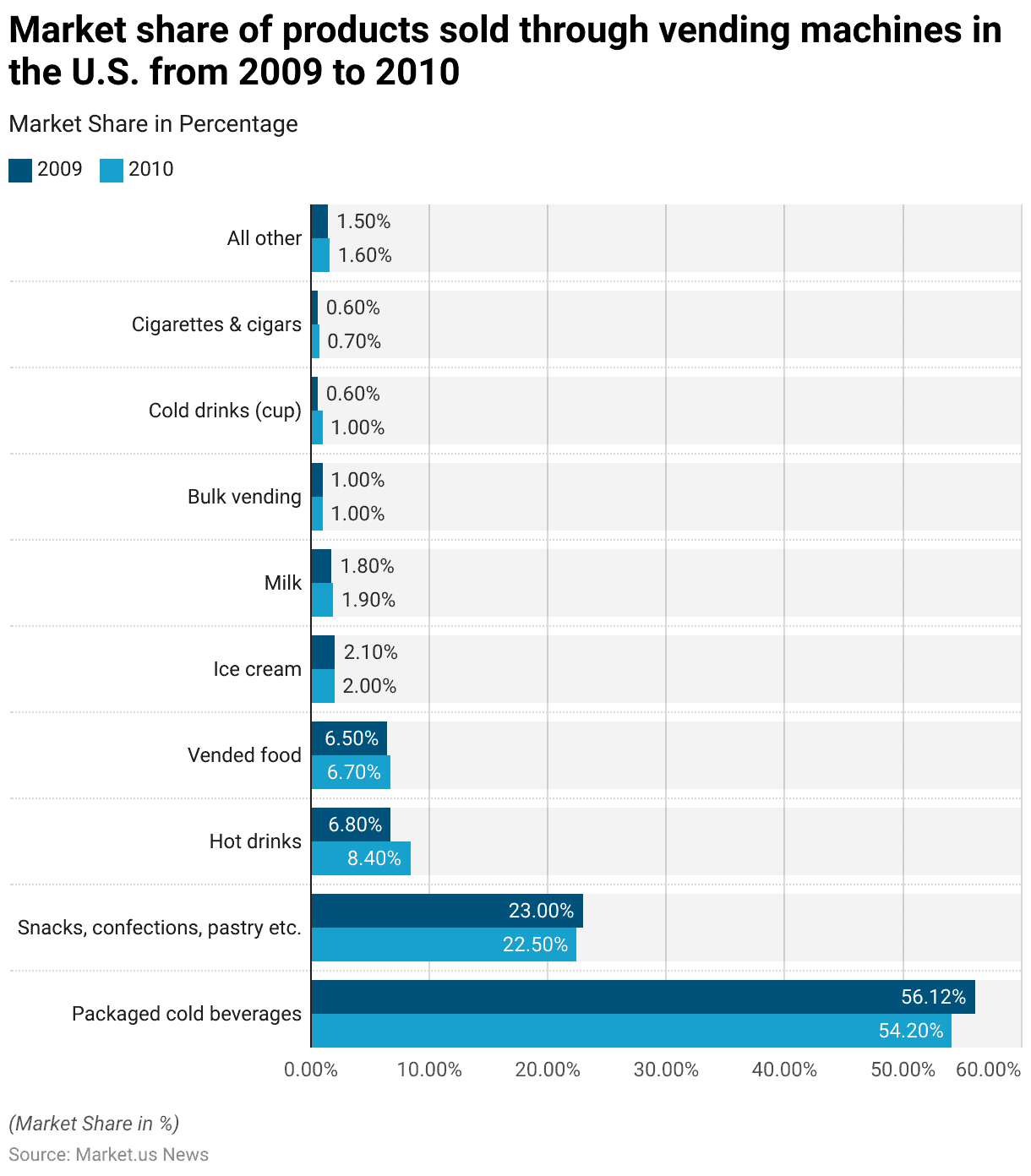
Price Range of Various Goods Sold Through Vending Machine Statistics
- The vending machine industry is remarkably diverse. Offering a wide range of products that cater to various consumer needs and preferences. Items sold through vending machines range from inexpensive gumballs priced at $0.50 to luxury goods such as Beluga caviar, which costs $500 per ounce.
- Other unique items include live hairy crabs available for approximately $4 each and engagement rings priced at $800.
- Practical items like live earthworms for fishing can be found for $3.50 per dozen, while morning-after pills are available for $25.
- Additionally, vending machines have adapted to current health needs by selling COVID-19 essentials like hand sanitizers and masks, with prices ranging from $4.25 to $14.50.
- This wide array of goods highlights the versatility and broad appeal of vending machines in the modern market.
(Source: Zachary Crockett / The Hustle)
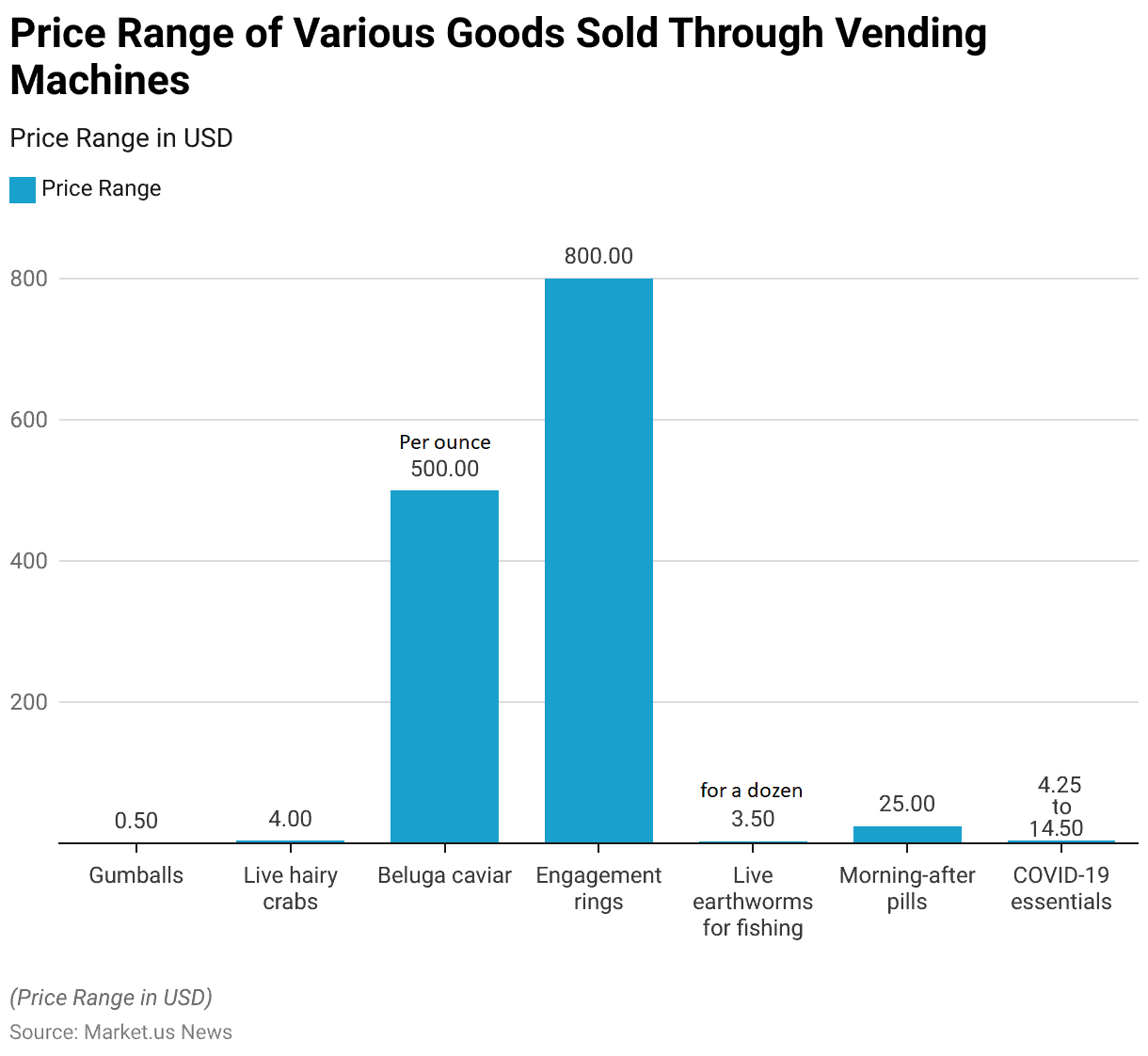
Number of Vending Machine Operators – By Employment Size Statistics
- As of June 2023, the vending machine industry in Canada was characterized by a diverse range of operators based on employment size.
- There were 162 establishments with 1-4 employees, making up the majority of the industry.
- Medium-sized operations with 5-9 employees accounted for 37 establishments, while those with 10-19 employees numbered 20.
- Slightly larger companies with 20-49 employees comprised 13 establishments.
- There were three establishments, each in the categories of 50-99 employees and 100-199 employees.
- Additionally, there was one large-scale operation with over 500 employees.
- This distribution underscores the prevalence of small and medium-sized enterprises within the Canadian vending machine industry.
(Source: Statista)
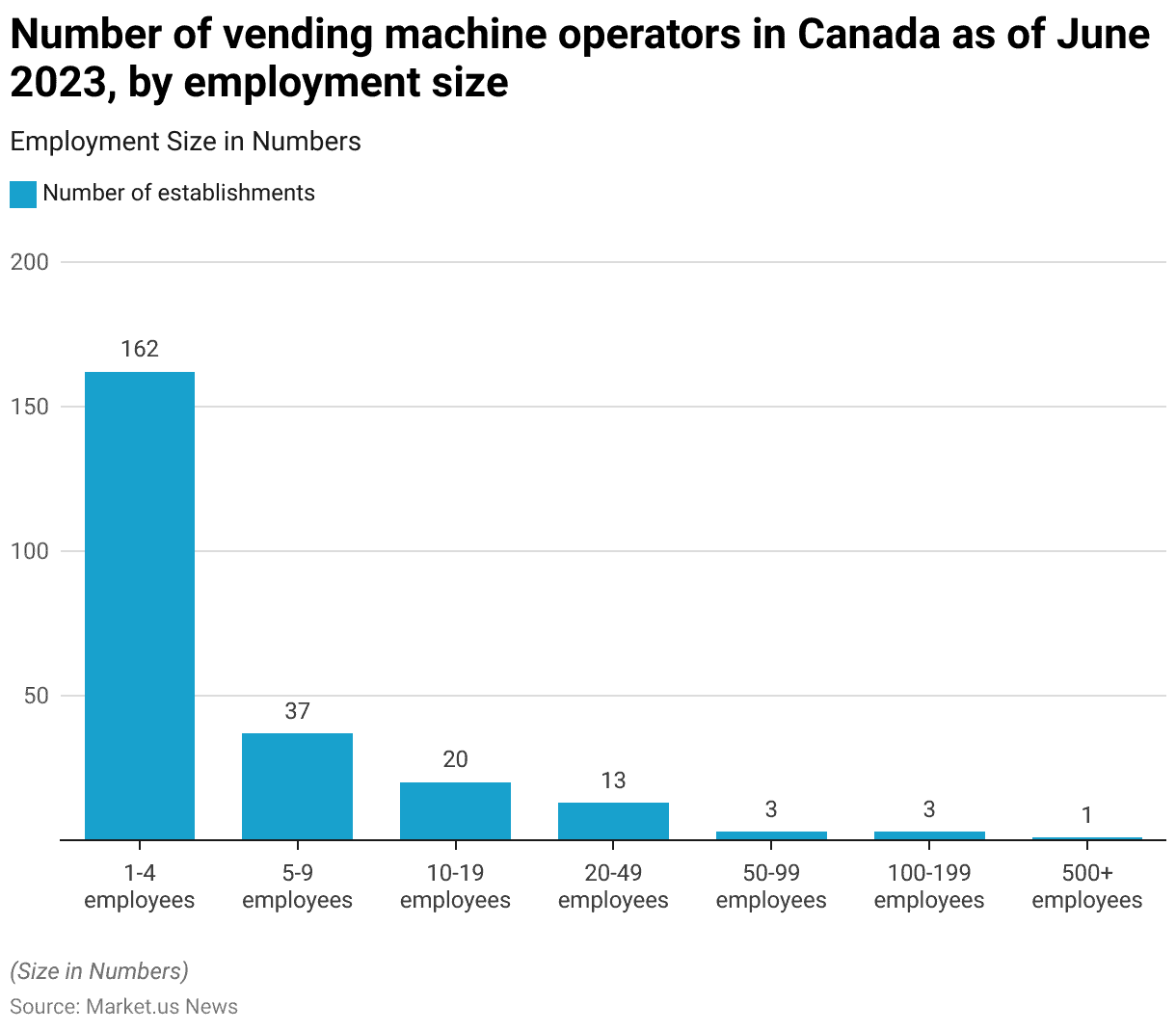
Vending Machines Sales Statistics
Vending Machines: Sales Volume of Vended Products
- The total sales volume of vending machines in the U.S. exhibited a general upward trend from 1999 to 2007, followed by a decline through 2010.
- In 1999, the sales volume was USD 36.6 billion, which increased to USD 38.7 billion in 2000 and reached USD 41 billion in 2001.
- The upward trajectory continued, with sales hitting USD 41.1 billion in 2002, USD 42.2 billion in 2003, and USD 44.2 billion in 2004.
- The growth peaked in 2007 with a total sales volume of USD 47.5 billion.
- However, this was followed by a decline, with sales dropping to USD 45.6 billion in 2008, USD 42.9 billion in 2009, and USD 42.2 billion in 2010.
- This fluctuation reflects the impact of economic conditions and changing consumer behaviors on the vending machine industry over this period.
(Source: Statista)
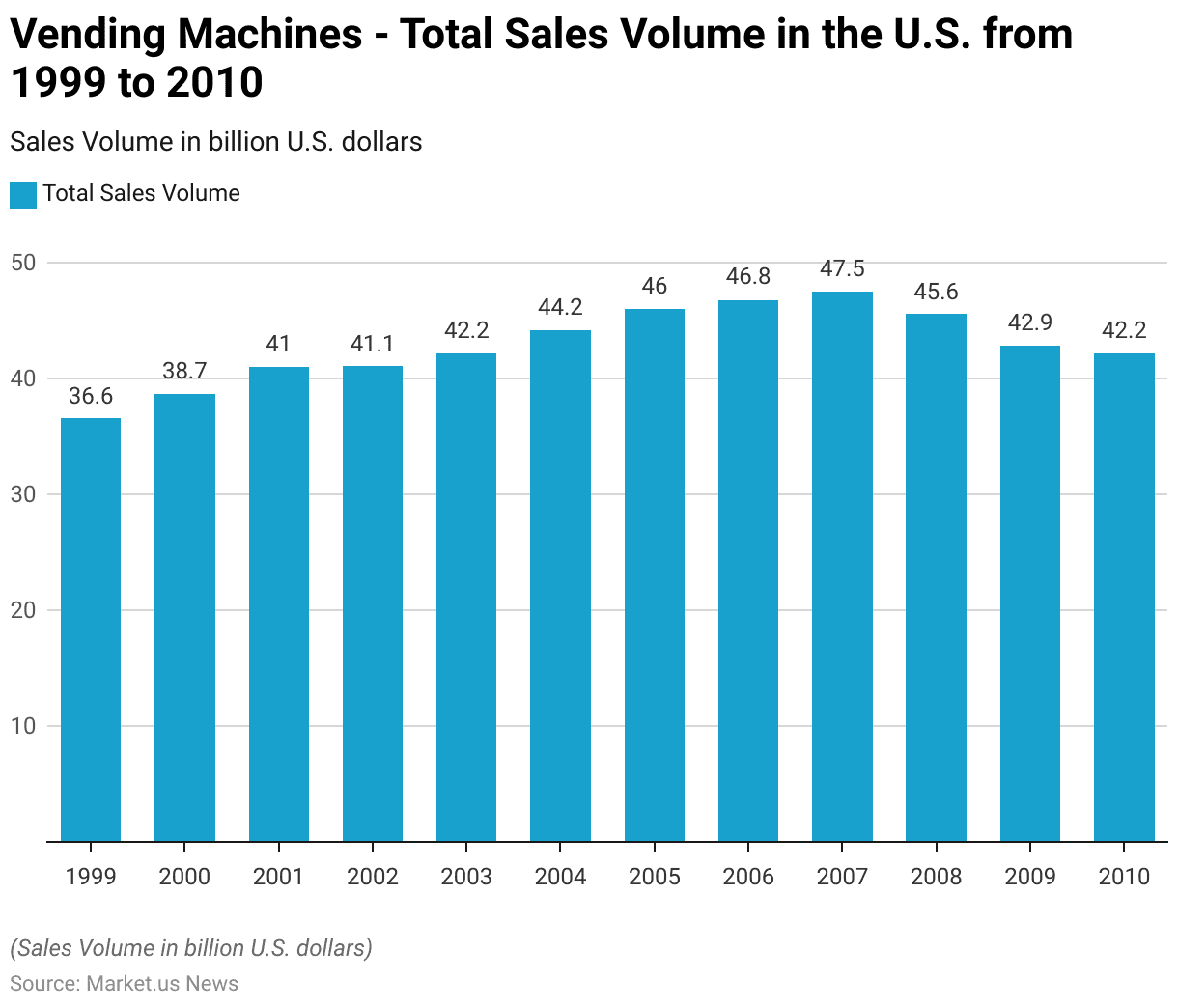
Retail Sales Revenue of Vending Machines
- The retail sales revenue of vending machines in China has shown significant growth from 2017 to 2022, with further projections indicating continued expansion until 2027.
- In 2017, the market generated 13.13 billion yuan in sales, which increased to 19.29 billion yuan in 2018.
- This growth trajectory continued, reaching 27.08 billion yuan in 2019.
- However, 2020 saw a decline to 21.43 billion yuan, likely due to the impacts of the COVID-19 pandemic.
- The market rebounded in 2021 with sales of 27.12 billion yuan and further increased to 28.91 billion yuan in 2022.
- Projections for future growth are robust, with anticipated sales reaching 35.6 billion yuan in 2023, 42.2 billion yuan in 2024, and 51.55 billion yuan in 2025.
- The upward trend is expected to continue, with estimates of 62.13 billion yuan in 2026 and 73.93 billion yuan by 2027.
- This indicates a strong and growing market for vending machines in China, driven by increasing consumer demand and advancements in vending technology.
(Source: Statista)
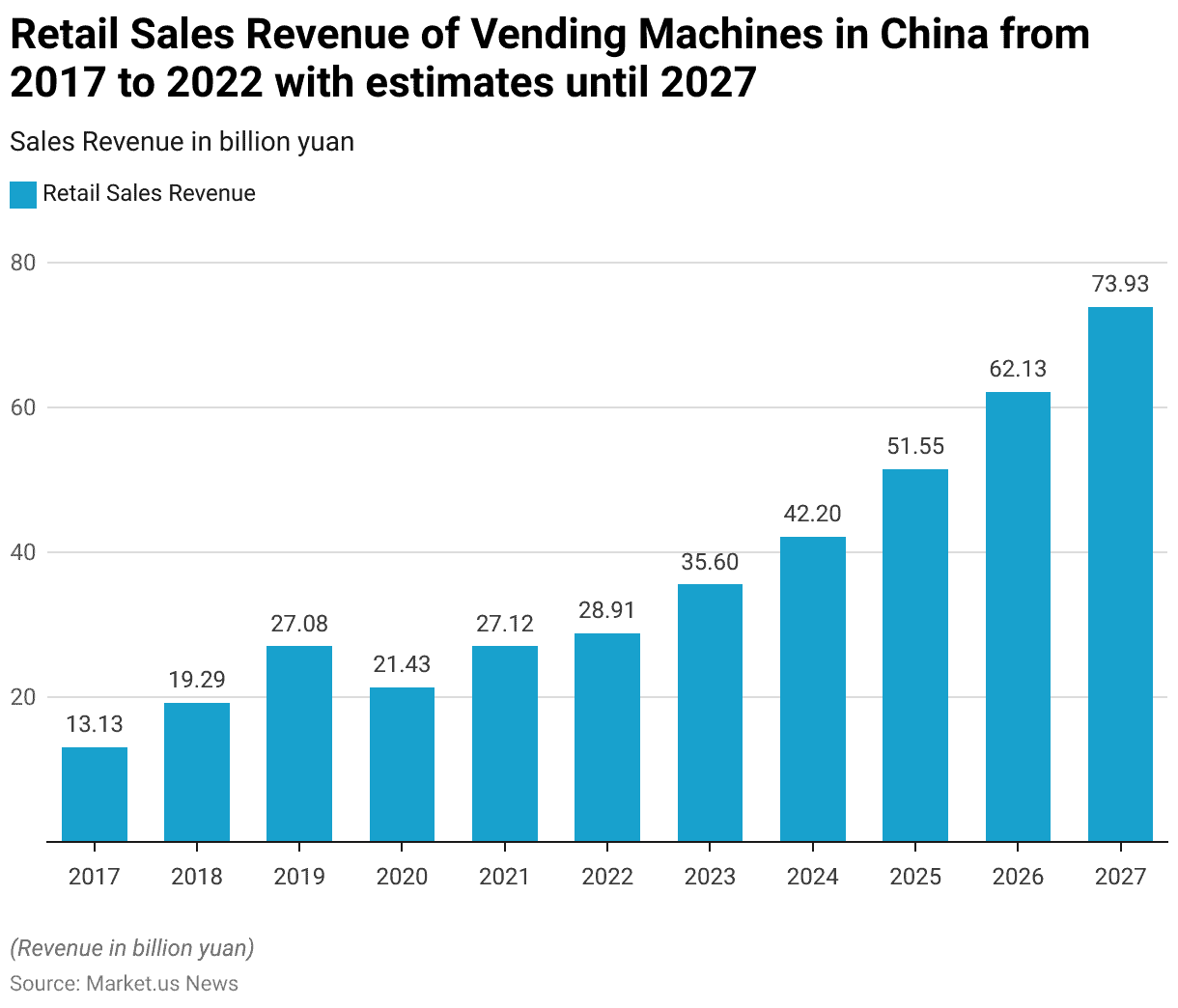
Unit Economics of Vending Machine Items
- The typical per-unit margins for various vending machine goods show significant profitability across different categories.
- For beverages, a 16 oz. bottle of water costs $0.14 and sells for $1.00, resulting in a profit of $0.86 and an 86% margin.
- Fruit snacks, costing $0.12 and selling for $0.50, yield a $0.38 profit with a 76% margin.
- Granola bars cost $0.14 and sell for $0.50, providing a $0.36 profit and a 72% margin.
- Gummy bears, with a cost of $0.30 and a sale price of $1.00, offer a $0.70 profit and a 70% margin.
- Similarly, Oreo cookies cost $0.31, sell for $1.00, and have a profit margin of 69%.
- Gatorade, priced at $0.54 per unit and sold for $1.50, has a profit of $0.96 and a 64% margin.
- Honey Buns, costing $0.37 and selling for $1.00, yield a 63% margin with a $0.63 profit.
- Soda, costing $0.49 and selling for $1.25, results in a $0.76 profit and a 61% margin.
- Other notable items include donuts (56% margin), chips (55% margin), Reese’s Peanut Butter Cups (53% margin), Sour Patch Kids (49% margin), gum (47% margin), M&Ms, Snickers, and Skittles (each with 46% margins), and Monster Energy drinks, which, despite a higher cost of $1.42 and a sale price of $2.50, provide a profit of $1.08 and a 43% margin.
- This data highlights the diverse profitability of products sold through vending machines, with snacks and beverages offering particularly high margins.
(Source: Zachary Crockett / The Hustle)
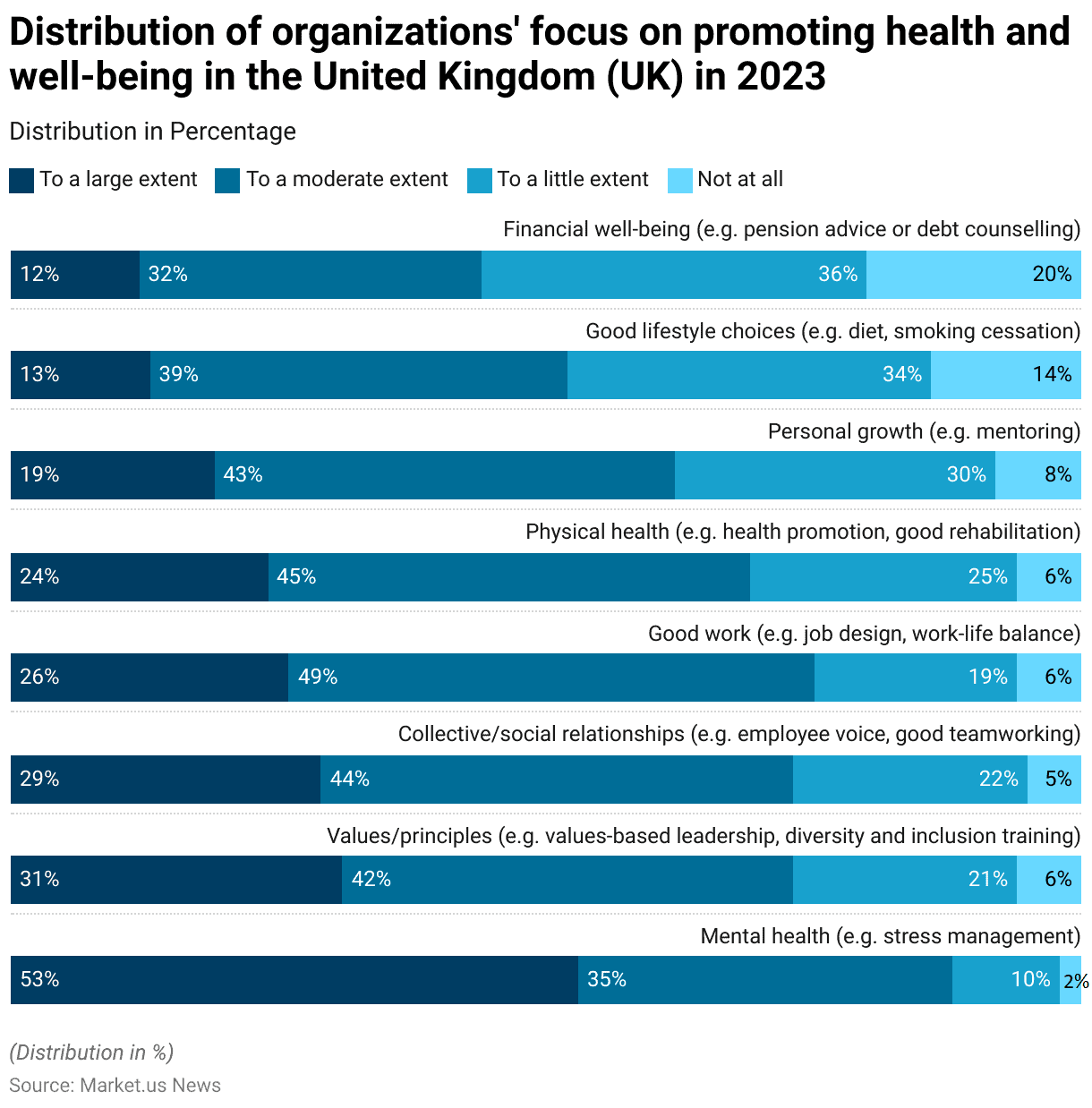
Consumer Preferences for Vending Machines
Vending Machine Shopping vs. Store Shopping
- When comparing the shopping experience of using vending machines to shopping at regular retail stores, respondents shared varied sentiments.
- A significant portion, 14.6%, felt that vending machine shopping was much worse than traditional store shopping, while 25.5% considered it somewhat worse.
- Additionally, 17.8% of respondents found vending machine shopping slightly worse. Conversely, 27.1% of respondents perceived no difference, stating that the experience was about the same.
- Positive perceptions were less common, with 4.0% finding vending machine shopping slightly better and another 4.0% considering it somewhat better.
- A smaller segment, 6.9%, felt that shopping through vending machines was much better compared to retail stores.
- These responses indicate a diverse range of opinions on the convenience and satisfaction of vending machine shopping relative to traditional retail experiences.
(Source: Journal of Consumer Satisfaction, Dissatisfaction, and Complaining Behaviour)
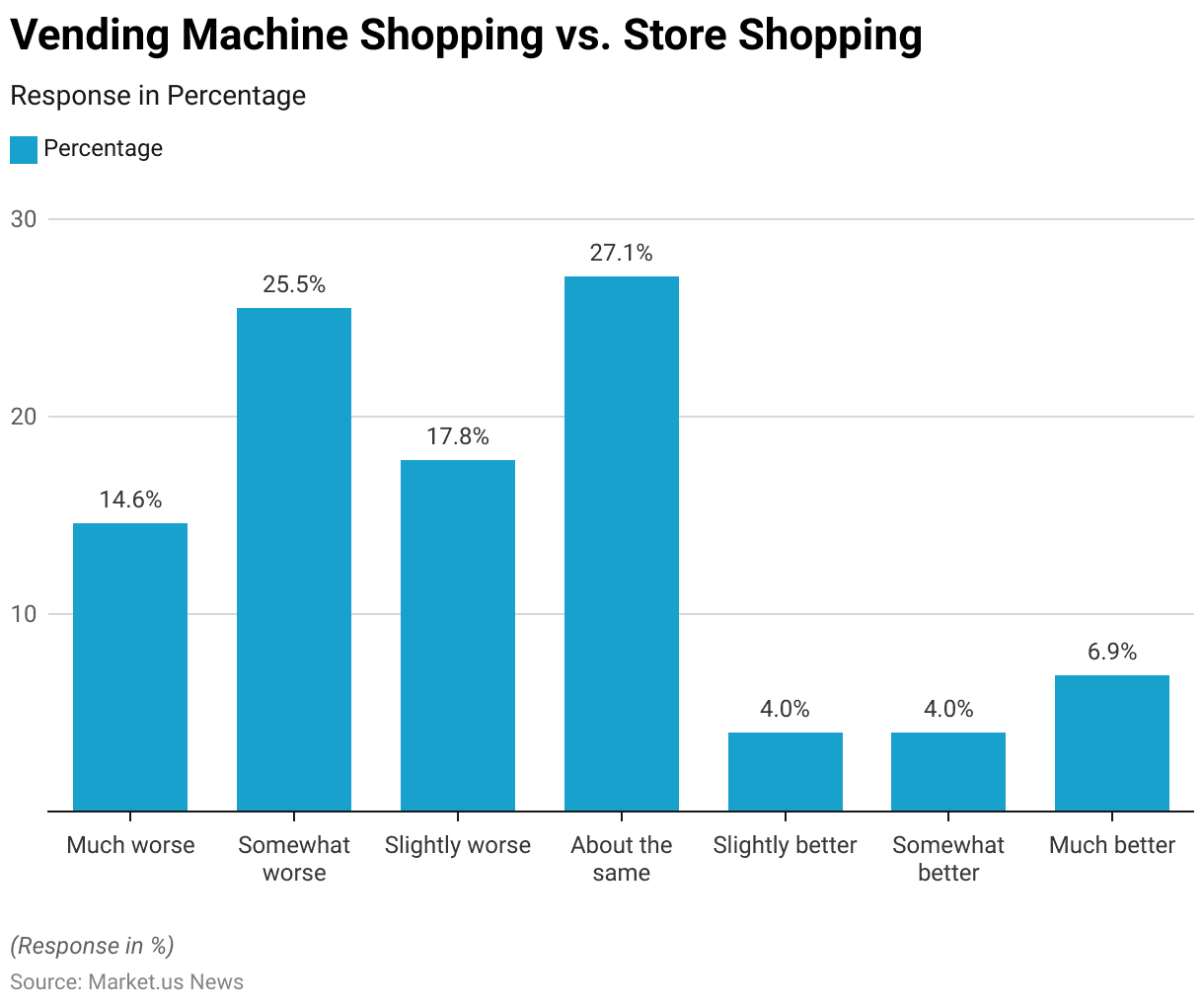
Dissatisfying Experiences with Vending Machine
- Dissatisfying experiences with vending machines have been reported across several categories, with machine malfunctions being the most frequent issue, occurring 109 times.
- Another significant problem is the inadequate or non-existent system for requesting refunds and filing complaints, which was cited 63 times.
- Lack of responsiveness to complaints was noted 37 times, indicating a gap in customer service.
- The poor quality of food items in vending machines was mentioned 20 times, reflecting concerns about product standards.
- Additionally, inadequate service related to vending machine operations was reported 11 times, and other miscellaneous issues were mentioned four times.
- These findings highlight several areas where vending machine operators can improve to enhance customer satisfaction.
(Source: Journal of Consumer Satisfaction, Dissatisfaction, and Complaining Behaviour)
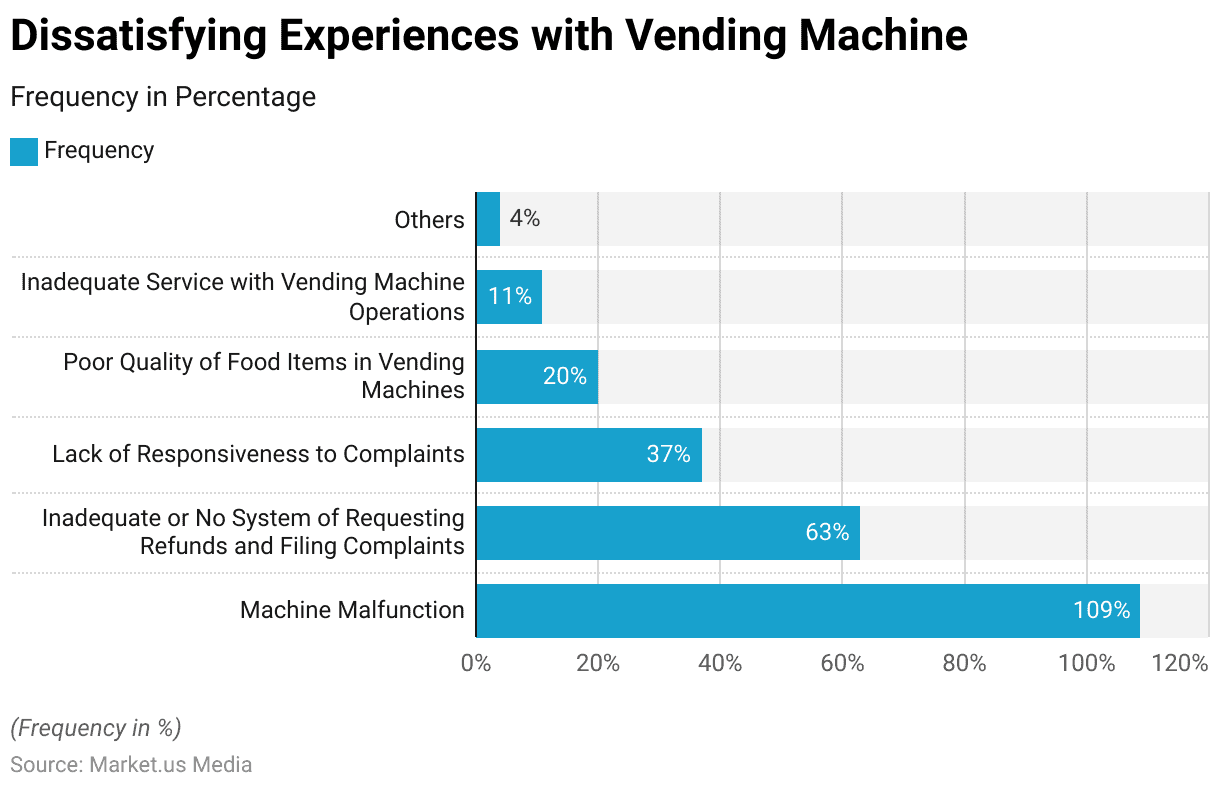
Suggestions for Improvements
- Users have made several suggestions to improve the overall experience of using vending machines.
- The most frequent recommendation, mentioned 53 times, is to offer a wider variety of items.
- Closely following this, 42 respondents suggested providing healthier and more nutritious options.
- Enhancing the refund and complaint processes was recommended 35 times, indicating a significant area for service improvement.
- The price reduction was another suggestion, cited 22 times.
- Improving the mechanical functioning of the machines was mentioned 19 times while increasing the number of vending machines and their locations received 14 mentions.
- Better maintenance of machines was suggested 13 times, and improving attendant services was noted 11 times.
- Enhancing the quality and freshness of items carried was mentioned ten times, and improving the convenience of vending machine locations was suggested by eight respondents.
- Introducing new technology to vending machines and other miscellaneous suggestions were each mentioned six times.
- These suggestions highlight key areas for improvement to enhance customer satisfaction and vending machine reliability.
(Source: Journal of Consumer Satisfaction, Dissatisfaction, and Complaining Behaviour)
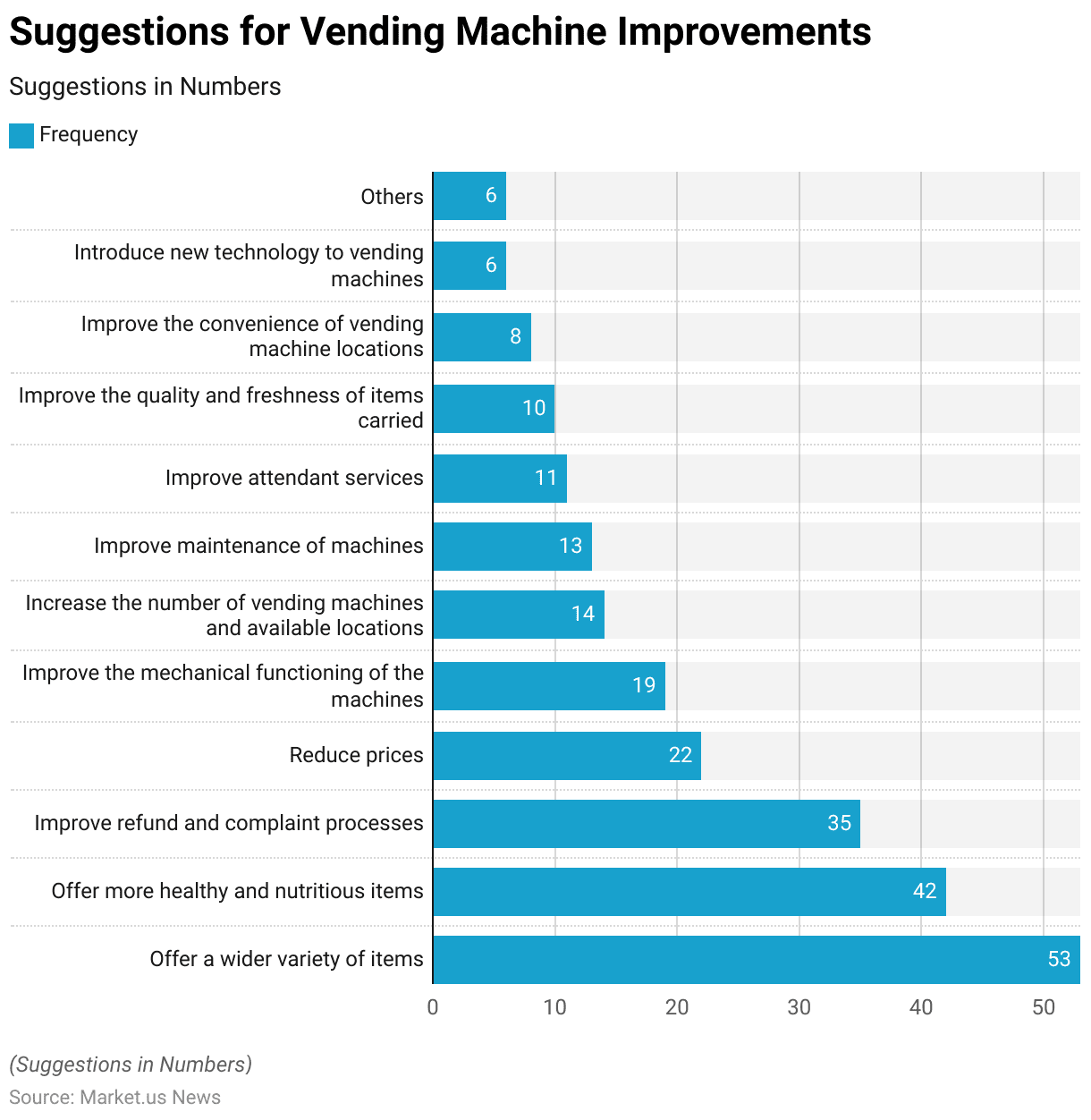
The Role of Healthy Snack Vending Machines in Employee Wellness Programmes
Health and Well-being
- In 2023, organizations in the United Kingdom have placed varying levels of focus on promoting health and well-being among employees as part of their wellness programs.
- Mental health initiatives, such as stress management, are emphasized to a large extent by 53% of organizations, with 35% addressing it to a moderate extent, 10% to a small extent, and 2% not at all.
- Efforts related to values and principles, including values-based leadership and diversity training, are promoted to a large extent by 31% of organizations, moderately by 42%, to a small extent by 21%, and not at all by 6%.
Social
- Collective and social relationship initiatives, such as fostering employee voice and teamwork, are a major focus for 29% of organizations, with 44% addressing these issues moderately, 22% to a small extent, and 5% not at all.
- Good work practices, including job design and work-life balance, are promoted extensively by 26% of organizations, moderately by 49%, to a small extent by 19%, and not at all by 6%.
- Physical health, covering health promotion and rehabilitation, is a key focus for 24% of organizations, moderately addressed by 45%, to a small extent by 25%, and not at all by 6%.
Personal
- Personal growth opportunities, such as mentoring, are emphasized to a large extent by 19% of organizations, with 43% providing moderate focus, 30% to a small extent, and 8% not at all.
- Good lifestyle choices, including diet and smoking cessation, are a major focus for 13% of organizations, moderately by 39%, to a small extent by 34%, and not at all by 14%.
- Finally, financial well-being initiatives, such as pension advice and debt counseling, are promoted extensively by 12% of organizations, moderately by 32%, to a small extent by 36%, and not at all by 20%.
- These varying levels of focus highlight the multifaceted approach organizations are taking to promote comprehensive employee wellness in the UK.
(Source: Statista)
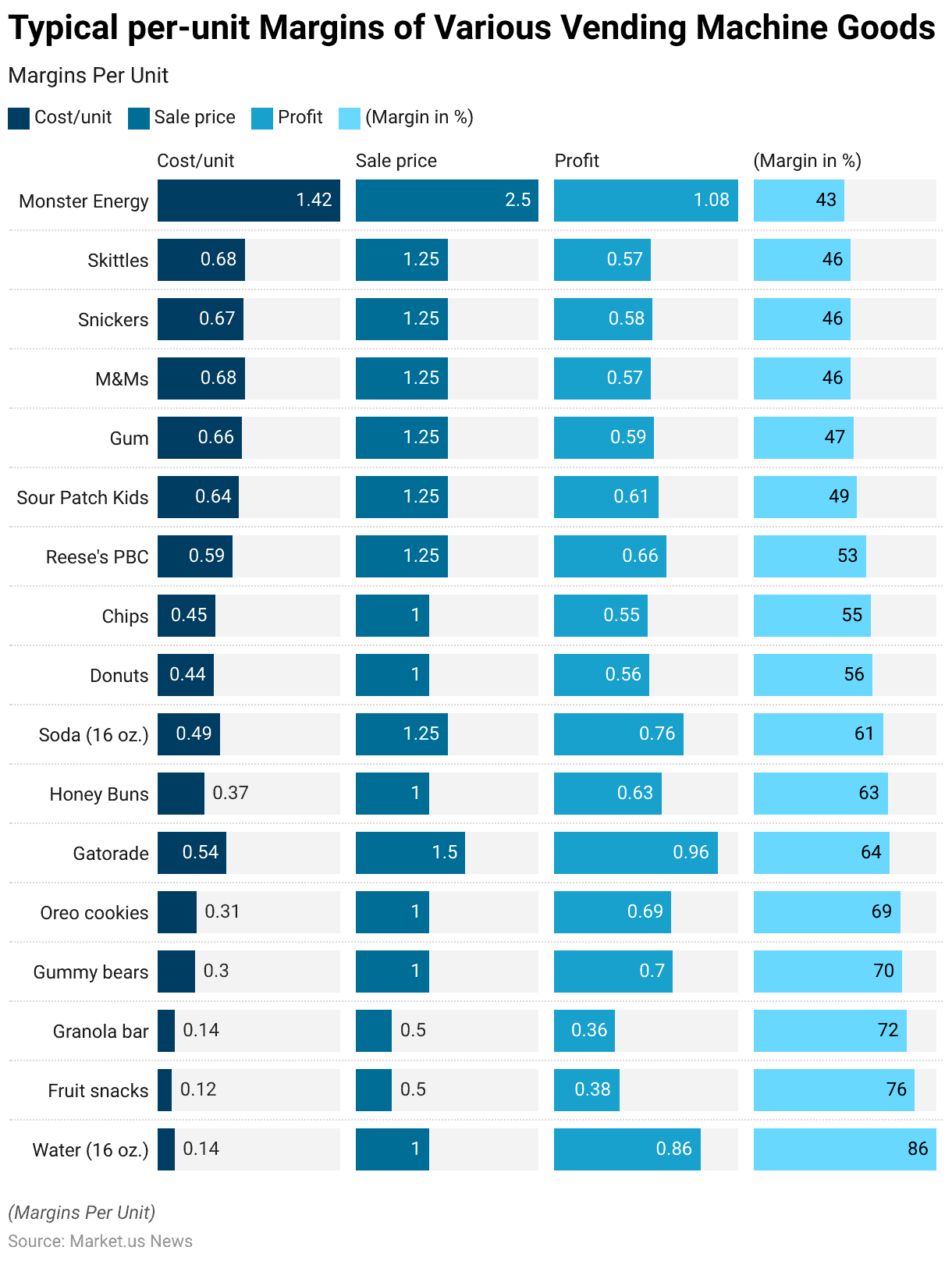
Cost and Investments in Vending Machines
- Investing in vending machines has become increasingly popular, offering a range of opportunities and varying levels of initial investment.
- The cost to purchase a new vending machine typically ranges from $3,000 to $5,000, while used machines can be acquired for about half that price.
- For instance, a basic snack machine might cost between $3,000 and $4,000 new or $1,500 to $2,500 used. Combo machines, which offer both snacks and beverages, are priced around $5,000 to $6,000 new and $2,500 to $3,500 used.
- Higher-tech machines that accept cashless payments and offer modern features such as remote monitoring and AI-based inventory management can command higher prices but also attract more consumers.
- These advanced machines are increasingly integrated into the market to meet the demands of tech-savvy customers and to provide seamless experiences.
- Investments in vending machines have been significant. Companies like Crane Merchandising Systems and eVending have been at the forefront, incorporating advanced technology and diverse product offerings to enhance customer experience and operational efficiency.
- In summary, investing in vending machines involves considering various factors such as machine type, technology features, and location to maximize ROI.
- The initial cost varies but with strategic placement and a focus on high-demand products, vending machine investments can become highly profitable.
(Sources: eVending, eFinancialModels)
Recent Developments
Acquisitions:
- Crane Holdings’ Acquisition of CPI: In March 2023, Crane Holdings announced the acquisition of Crane Payment Innovations (CPI), a global leader in vending solutions. This acquisition aims to enhance Crane’s capabilities in payment solutions and expand their market presence in the vending industry.
- SandenVendo and Vendekin Technologies Partnership: SandenVendo America, Inc. partnered with Vendekin Technologies in December 2021 to integrate advanced vending machine controllers into their products. This collaboration aims to enhance the functionality and efficiency of vending machines through cutting-edge technology.
New Product Launches:
- Reverse Vending Machines in Singapore: In May 2022, RVM Systems, a Swedish vending machine company, announced the installation of reverse vending machines in Singapore. These machines can process 100 containers simultaneously and provide incentives like shopping rewards and ActiveSG credits for recycling efforts.
- NFT Vending Machine by Neon: In February 2022, Neon launched the world’s first NFT vending machine in New York City’s Financial District. This machine allows users to purchase NFTs using fiat currency, debit, and credit cards, making digital collectibles more accessible.
Funding:
- Investment in IoT-Based Vending Solutions: Companies are investing heavily in IoT-based vending machines that enhance customer interaction and operational efficiency. These machines use real-time data to adjust pricing, improve security, and ensure the safety of perishable items, thereby increasing customer satisfaction and revenue growth.
Market Growth:
- Global Market Expansion: The growth is driven by increasing consumer demand for convenient, ready-to-eat meals and beverages.
- Regional Insights: North America dominated the market in 2022, accounting for 45.8% of the global market share. The U.S. is the largest market in the region, driven by high demand for convenient food options and advanced self-service technologies. Europe and Asia-Pacific are also experiencing significant growth due to economic recovery and rising disposable incomes.
Innovation and Trends:
- Health-Focused Products: Vending machines are increasingly stocking health-focused products such as gluten-free, vegan, and low-sugar snacks to cater to health-conscious consumers. This trend is expected to grow as more people adopt healthier eating habits.
- Enhanced Payment Options: Modern vending machines are incorporating cashless payment methods, including mobile payments and virtual currencies like Bitcoin, to provide more convenience to customers.
- Sustainability Initiatives: The vending industry is moving towards sustainable practices, with eco-friendly machines powered by renewable energy sources like solar power. These initiatives aim to reduce the environmental impact of vending machines.
Conclusion
Vending Machine Statistics – In summary, vending machines represent a burgeoning sector in the retail landscape, driven by technological advancements and shifting consumer preferences towards convenient, on-the-go options.
The market’s growth is propelled by factors such as the increasing adoption of cashless transactions and a widening product selection.
Looking forward, expansion opportunities abound, particularly through innovation in product offerings and the integration of data analytics.
However, stakeholders must remain vigilant of challenges such as regulatory compliance and heightened competition.
By embracing consumer trends and fostering strategic partnerships, industry players can navigate these challenges and capitalize on the promising prospects of the vending machine market.
FAQs
Vending machines operate by holding products in rows controlled by electric coils. When a customer selects and pays for a product, the electric motor activates the coil, dispensing the item into a collection tray. Modern vending machines often use sensors to detect whether the product has been delivered, ensuring reliability.
Vending machines can sell a wide range of products, including snacks, beverages, hot drinks, fresh food, ice cream, and even non-food items like electronics, personal care products, and over-the-counter medications.
The cost to start a vending machine business varies based on the type of machines and products. Basic snack machines can cost between $3,000 to $4,000 new, while used machines may cost $1,500 to $2,500. Combo machines and high-tech machines with advanced features can range from $5,000 to $6,000 new.
Regular maintenance includes cleaning, restocking inventory, checking for mechanical issues, and updating software. It’s also important to monitor the machines remotely for stock levels and performance to prevent downtime and ensure optimal operation.
Modern vending machines accept a variety of payment methods, including coins, cash, credit and debit cards, and mobile payments. Some machines also support contactless payment options like Apple Pay and Google Wallet.
Discuss Your Needs With Our Analyst
Please share your requirements with more details so our analyst can check if they can solve your problem(s)





